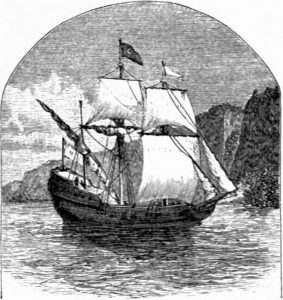1601, Irish earls (Hugh O’Neill and Hugh Roe O’Donnell are leaders)—in eighth year of resisting Elizabeth I’s conquest—join Spanish forces under siege by English in Kinsale, in south of Ireland. Spanish lose six ships in naval battle off Castlehaven, Dec. 6. Seige ends in withdrawal of Irish, and surrender of their Spanish allies, Dec. 24.
English impose control over all Ireland by 1603. O’Neill; O’Donnell’s brother, Rory; and their followers flee to Europe, 1607. Their Ulster domains are subsequently seized by English lords.
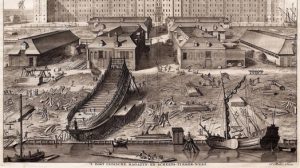 Amsterdam shipyard.
Amsterdam shipyard.
1602, Partly in response to England’s new East India Company (1600), Johan van Oldenbarnevelt and Staats General direct merger of small trading firms into a Dutch East India Company.
This first modern corporation (selling stock to raise 6.5 million guilders) becomes an economic powerhouse through war as much as through exploration and monopoly trade practices.
Target one: Portugal’s Far East empire. Quick payoff: Within a year, a Portuguese galleon is captured off Singapore with high-value cargo of Chinese porcelains and musk that increases company’s capital by 50 percent.
 King James.
King James.
1603, Queen Elizabeth I, 69, dies March 24, ending a 44-year reign. James I, 36, ascends the throne. Because he is already James VI of Scotland, the kingdoms of England and Scotland are united under a single British monarch.
The new king is eager to end 19 years of fighting with exhausted Spain; pre-war status quo agreed to in 1604, which requires English to end support for Dutch revolt.
1605, Port Royal, the first permanent European settlement north of Florida, is founded on the present-day Acadian peninsula of Nova Scotia. Taking part is Samuel de Champlain who three years later leads settlement of Québec.
Champlain engages peacefully with many Indian peoples, becomes first European to describe the Great Lakes, and oversees growth of New France until his death in 1635.

Cervantes, ex-slave.
1605, Miguel de Cervantes publishes Don Quixote in January, long after his soldiering days.
Badly wounded at Lepanto, he was captured at sea by Barbary pirates in 1575. He labored as a slave in Algiers for five years before being set free by the Trinitarians, a religious order specializing in ransoming Christian captives.
He alludes to his traumatic captive experience in many of his writings, including the prologue of Don Quixote, one of the first novels.
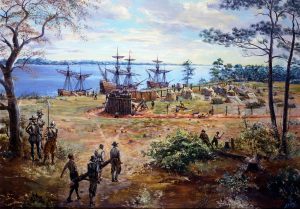 Building the first wall.
Building the first wall.
1607, Jamestown settlement (and colony of Virginia) established by English, their first to take root in North America. Named for Britain’s king of four years.
Of original 214 settlers, only 60 are alive (and preparing to return to England) when supply ships return in 1610.
By 1614, colony is self-sufficient and growing tobacco. Most new settlers from this point on are indentured servants.
Indentured servants make up most of the labor force of the English colonies in their early decades. They typically sign contracts to work for three to seven years in return for trans-Atlantic passage (relatively expensive), room and board and, in many cases, land. Indenture contracts could be sold by holders; runaway servants were pursued and returned for reward.
Stats: Non-slave immigrants from Europe to the 13 colonies are estimated at 500,000 through 1774 (eve of American Revolution). Of that, perhaps 215,000 are indentured servants compared to 235,000 arriving free and clear.
An estimated 50,000 are “involuntary servants,” including Irish and Scottish rebels, political prisoners and enemy soldiers captured in the Wars of the Three Kingdoms (including the English Civil War). But their servitude is generally the same three to seven years of the voluntary indentured.
Total imported slaves are estimated at 325,000 through 1774.
1607, Dutch fleet under Jacob van Heemskerk destroys Spanish fleet anchored in Bay of Gibraltar, April 25. Leads to a complex 12-year truce, in which the Dutch Republic wins de facto recognition by the Spanish Crown.
1607, Santa Fé founded by Pedro de Peralta. Three years later it becomes the new capital of the 12-year-old province of New Mexico in New Spain. Main object is to convert Pueblo peoples of nearby advanced adobe villages. De Peralta builds a Palace of Governors that still stands.
Half Moon.
1609, Henry Hudson sails into Upper New York Bay and up the river to present-day Albany, September. He notes brackish salt water as far up as present-day Newburgh, which encourages him in search for a route to Asia on behalf of the Dutch East India Company. Instead he finds Lenape and other tribes and an abundance of beaver.
1609, Scottish planters take over estates confiscated from Irish nobles under the Plantation of Ulster scheme imposed by James I.
They begin moving in thousands of tenant farmers from Lowland Scotland (mostly Presbyterian) and Northern England (largely Anglican).
Before, Ulster was the province most resistant to the English. Irish Catholics are to be removed or otherwise marginalized.
1609, King Philip III orders expulsion of Moriscos, descendants of Muslim families who converted to Catholicism. Of 500,000-plus Moriscos, perhaps 60%, most of them from Valencia (where they comprise a third of the population) and Aragon, are actually forced to leave. Most go by ship to Morocco or the Barbary states of Algiers, Tunis and Tripoli. And tens of thousands of the deported will eventually find their way back.
1611, A new English translation of the Bible, authorized by the Church of England under James I, is issued in London. Scholars go back to the earliest Greek and Hebrew texts in creating this “King James’s Bible,” in part to meet problems in earlier texts cited by Puritans.
1612, Brazil challenges São Tomé as primary sugar producer for Europe. Indians are being replaced by enslaved Africans, most now coming from Angola, which is exporting 10,000 slaves a year. Angola becomes a prime slave source for, first, São Tomé, and then for Brazil and rest of the Americas, including English colonies.
1615, Bento Benha Cardosa, Portuguese governor of Angola, based in Luanda, begins alliance with Imbangala, a unique clan of marauding warriors who battle the Ndongo Kingdom and deliver large numbers of captives to Portuguese slave merchants.
The Imbangala: Of mysterious origin, they are disciplined and ruthless, and build their numbers by capturing young boys from surrounding tribes and indoctrinating them into ways of war. They live to fight and to drink palm wine, sometimes practice cannibalism, and work with Portuguese to dominate central Angola.
The Imbangala later establish the Kasanje Kingdom along the upper Kwanza river, 1630, eventually abandon their rapine ways in favor of communal life, and maintain independence from Portuguese governors.
1617, Dutch take over Gorée Island at Cape Verde (present-day Dakar) and build two forts. They hold it until 1664.
1617, Manuel Cerveira Pereira founds Portuguese settlement at Benguela (southern Angola), which develops into the southernmost slave port on Africa’s West Coast.
Portuguese steer clear of arid, sparsely populated region further south (present-day Namibia) and Cape of Good Hope (where Khoikhoi people defeated them in 1510).
1618–1648, Thirty Years’ War, fought mostly in Germany and Central Europe, pits France and Sweden against the Habsburgs’ Spanish and Austrian empires.
Overlaps numerous subordinate conflicts, including Eighty Years’ War for Dutch independence and Portugal’s fight for self-rule, both against Spain, the latter beginning in 1640.
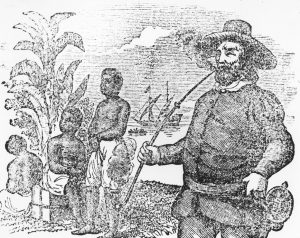 Slaves to Virginia.
Slaves to Virginia.
1619, Two English ships, White Lion and Treasurer, sailing out of the Netherlands, intercept Portuguese slaver São João Bautista (bound for Vera Cruz) off Campeche in July. After seizing about 60 enslaved Africans (of 150 who survive from original 350-slave contingent), the ships set course for Virginia.
White Lion arrives at Point Comfort, near Jamestown, where Capt. John Jope sells "20 and odd Negroes" for food. They are the first Africans to reach the Virginia colony. Four days later, Treasurer sells two or three of the Africans aboard.
Record indicates these first slaves are accepted as “indentured servants,” implying they could be freed after several years’ work. If they were, that’s not recorded.
1619, Pirate captains led by Jan Janszoon (a Netherlander captured young by pirates and now Muslim), declare the port of Salé (Morocco) as their republic. 10,000 Moriscos, expelled from Spain despite accepting conversion to Christianity, settle here, 1624. Janszoon later captures island of Lundy in the Bristol Channel, 1627, and from there raids Ireland (Baltimore) and even Iceland, taking hundreds of Christian captives who are sold into slavery in North African ports.
Christian slaves: Between 1530 and 1780 (150 years), an estimated 1.0-1.5 million Christians are seized from ships and villages by Barbary pirate raiding Europe’s Mediterranean and Atlantic coasts. Many are ransomed. Enslaved men are often assigned to galleys, still important in Mediterranean warfare, or to construction. Women are sent to households or to be concubines to various sultans, emirs, viziers and other high officials. Relatively few of either gender work in fields or mines. Race and color not defining factors.
Descendants: Two of Janszoon’s sons, by a Moorish wife, make their way in the 1630s to New Amsterdam, where they are described as “mulatto” and become merchants. Anthony Janszoon van Salee, a Koran-reading Muslim, is said to be a great-great-great-grandfather of Cornelius Vanderbilt.
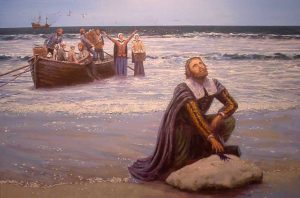 Pilgrims' landing.
Pilgrims' landing.
1620, Pilgrims depart Plymouth on Mayflower, arriving at Cape Cod 10 stormy weeks later, Nov. 11. Because they missed planned destination, Virginia, they draw up Mayflower Compact to govern themselves.
Half of the 102 settlers and many of the 30 crew die over the winter; survivors thank Wampanoag Indians for their aid.
1620, Portuguese continue to develop northeast Brazil into a major producer of sugar cane, produced on slave plantations, eventually taking the lead from little São Tomé.
By 1625, Imbangala warriors, Portuguese slave ships and Brazil sugar plantations account for the great majority of the 11,500 enslaved people shipped from Angola to Brazil, which is 51 percent of all African slaves transported in all ships to the Americas that year.
Many are shipped through São Tomé. Most go to northern Brazil, via ports of Recife and Olinda in Pernambuco, and to Salvador in Bahia.
1621, Dutch East India Company’s success against Portugal in Far East (taking control of Straits of Malacca, 1615) leads to formation of new Dutch West India Company. Mission: To acquire colonies in the New World (Brazil is their leading target), to seize gold gathered at Portuguese factory at Elmina on the Gold Coast, and to take over Portuguese slave trade in Angola.
1622, Powhatan warriors, desperate to stop expansion of Jamestown settlers, massacre nearly 400 in farms beyond the fort, March 22. Twenty women are made captives. This ends period of peace that began with 1614 marriage of teenaged Pocahontas and John Rolfe (she bore a son and died three years later in England).
Settlers retaliate by inviting Powhatans to a sitdown, poisoning and killing 250, and then destroying abandoned villages. Hundreds die on both sides in a third, bloody war in 1644, but Powhatans and allies are forced to depart, the first of centuries of forced Indian removals in the present-day U.S.
A boy, William, is born (and soon baptized) to two of the first captive Africans landing in Virginia, Isabell and Anthoney, who married the previous year with support of their master, William Tucker. Family, who may have had indentured-servant status and is given Tucker’s name, is freed in 1635 and establishes a farm nearby.

